Related Research Articles
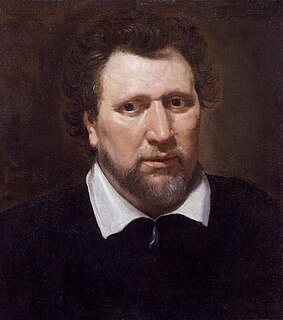
Benjamin Jonson was an English playwright and poet. Jonson's artistry exerted a lasting influence upon English poetry and stage comedy. He popularised the comedy of humours; he is best known for the satirical plays Every Man in His Humour (1598), Volpone, or The Fox, The Alchemist (1610) and Bartholomew Fair (1614) and for his lyric and epigrammatic poetry. "He is generally regarded as the second most important English dramatist, after William Shakespeare, during the reign of James I."

Thomas Middleton was an English Jacobean playwright and poet. He, with John Fletcher and Ben Jonson, was among the most successful and prolific of playwrights at work in the Jacobean period, and among the few to gain equal success in comedy and tragedy. He was also a prolific writer of masques and pageants.

Sir James Whitelocke SL was an English judge and politician who sat in the House of Commons between 1610 and 1622.
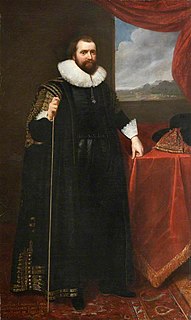
Lionel Cranfield, 1st Earl of Middlesex was an English merchant and politician. He sat in the House of Commons between 1614 and 1622 when he was raised to the peerage as Baron Cranfield.

Esmé Stewart, 3rd Duke of Lennox, KG, lord of the Manor of Cobham, Kent, was a Scottish nobleman and through their paternal lines was a second cousin of King James VI of Scotland and I of England. He was a patron of the playwright Ben Jonson who lived in his household for five years.
The Lady Elizabeth's Men, or Princess Elizabeth's Men, was a company of actors in Jacobean London, formed under the patronage of King James I's daughter Princess Elizabeth. From 1618 on, the company was called The Queen of Bohemia's Men, after Elizabeth and her husband the Elector Palatine had their brief and disastrous flirtation with the crown of Bohemia.

Lucy Russell, Countess of Bedford (1580–1627) was a major aristocratic patron of the arts and literature in the Elizabethan and Jacobean eras, the primary non-royal performer in contemporary court masques, a letter-writer, and a poet. She was an adventurer (shareholder) in the Somers Isles Company, investing in Bermuda, where Harrington Sound is named after her.

Katherine Clifton, 2nd Baroness Clifton, was an English-born Scottish peer.
Events from the 1610s in England.

Thomas Scott was an English preacher, a radical Protestant known for anti-Spanish and anti-Catholic pamphlets.
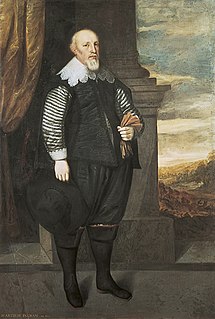
Sir Arthur Ingram was an English investor, landowner and politician who sat in the House of Commons at various times between 1610 and 1642. The subject of an influential biography, he has been celebrated for his "financial skill and ruthless self-interest", and characterized as "a rapacious, plausible swindler who ruined many during a long and successful criminal career". Probably of London birth but of Yorkshire background, he was a very extensive landowner in Yorkshire. He acquired and rebuilt the former Lennox residence at Temple Newsam near Leeds, which became the principal seat of his family, including the Lords Ingram, Viscount Irvine and their descendants, for over 300 years.
Count Simon VII of Lippe was a ruler of the Reformed county of Lippe-Detmold.
Sir Francis Stuart or Frank Stewart (1589–1635), sailor, aristocrat, Member of Parliament and courtier
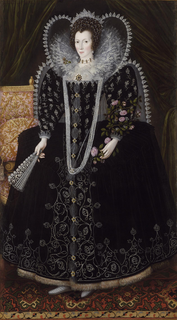
Frances Howard, Countess of Kildare, courtier, and governess of Princess Elizabeth, later Queen of Bohemia.
Elizabeth Howard, courtier to Anne of Denmark.
Sir Francis Gofton was an English courtier and administrator. He was an auditor of royal accounts and jewels, Chief Auditor of the Imprest from 1597 and Auditor of Mint from August 1603. Gofton acquired the manor of Heathrow, and houses in Stockwell and West Ham. He was often called "Auditor Gofton". The surname is frequently transcribed as "Goston" or "Guston"
John Auchmoutie of Scoughall was a Scottish courtier.
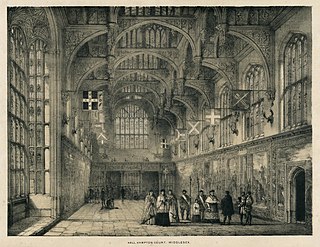
The Masque of Indian and China Knights was performed at Hampton Court on 1 January 1604. The masque was not published, and no text survives. It was described in a letter written by Dudley Carleton. The historian Leeds Barroll prefers the title, Masque of the Orient Knights.
References
- ↑ M. Eccles, "Thomas Gainsford, 'Captain Pamphlet'", Huntington Library Quarterly, 45 (1982), 259–63; B. Jonson, 'Execration upon Vulcan', 1623 or 24, in Ben Jonson: The Man and His Work, ed. C. H. Herford and P. Simpson (Oxford, 1925/1954), 2, 174.
- ↑ J. E, E. Boys, London's News Press and the Thirty Years War (Woodbridge and Rochester, NY., 2011), 127-142, 159-161, 171-5
- ↑ N. Brownlees, 'Spoken discourse in Early English Newspapers', in News Networks in Seventeenth Century Britain and Europe, ed/ J. Raymond (London and New York, 2006), 69-74.
- ↑ Cal. State Papers, Dom. 1623–5, 334 'Chamberlain', vol. 2, 579, Chamberlain to Dudley Carleton, 4 September.
![]() This article incorporates text from a publication now in the public domain : "Gainsford, Thomas". Dictionary of National Biography . London: Smith, Elder & Co. 1885–1900.
This article incorporates text from a publication now in the public domain : "Gainsford, Thomas". Dictionary of National Biography . London: Smith, Elder & Co. 1885–1900.